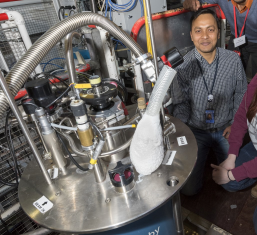Speaker
Description
Cuprate high-temperature superconductors have complex phase diagrams with multiple competing ordered phases. Understanding to which degree charge, spin, and superconducting orders compete or coexist is paramount for elucidating the microscopic pairing mechanism in the cuprate HTSs. In this talk, I will report some novel results of muon-spin rotation (μSR), AC susceptibility and X-ray diffraction experiments on uniaxial stress effect on the static spin-stripe order and superconductivity in the La214 cuprates [1,2]. We find that in the cuprate system La2-xBaxCuO4 with x = 0.115 and 0.135, an extremely low uniaxial stress of 0.05 GPa induces a substantial decrease in the magnetic volume fraction and a dramatic rise in the onset of 3D superconductivity, from 10 to 32 K; however, the onset of at-least-2D superconductivity is much less sensitive to stress [1]. These results show not only that large-volume-fraction spin-stripe order is anti-correlated with 3D superconducting (SC) coherence, but also that these states are energetically very finely balanced. Moreover, the onset temperatures of 3D superconductivity and spin-stripe order are very similar in the large stress regime. These results strongly suggest a similar pairing mechanism for spin-stripe order, the spatially-modulated 2D and uniform 3D SC orders, imposing an important constraint on theoretical models.
References
[1] Z. Guguchia et. al., Phys. Rev. Lett. 125, 097005 (2020).
[2] Z. Guguchia et. al., arXiv:2302.07015 (2023).

